
ALEEN TAN
Aleen Tan has been powerlifting for 8 years and competitively for 5. From a humble member of The Gym Nation, she has moved on to make numerous achievements in the sport under the guidance of Ronin Strength Co. Aleen has finished her Undergraduate Bachelor’s Honours degree program in Physiotherapy from the University of Sydney. Her research project was dedicated towards women’s preferences for pelvic floor information to advise future awareness strategies. With many more Women’s Health project ideas, she looks to specialise in Women’s Health Physiotherapy and furthering her studies in the near future.
Before we begin, this article is best viewed in desktop mode. In this last installation of the Leaking while Lifting series, I’ve worked with Jonus Ong to look at how deadlift technique, training programme and training mood can aid in reducing leaking while lifting. Due to the amount of content in this section, I’ve split it into 3 different articles for each topic. Adjusting Deadlift Technique to Reduce Leaking has been covered in an article last month and you can check that out here.
Let’s focus on optimising training programmes to reduce leaking occurrences in this article.
Remember Lily?
Our case study who wanted to compete at the end of the year but has experienced uncontrollable streams during sumo deadlifts since her 5th month of training? After a discussion with Lily and taking a look at her training programme, we discovered that:
Weight increments between training were not well tolerated i.e. Lily often drops training weights mid-session in order to finish her workout
Lily has difficulty managing recovery i.e. insufficient sleep/poor diet and nutrition/trained late the day before
Ongoing injury, soreness and fatigue i.e. Dull lower back pain
Goal Setting
First, let’s talk about goals. In Physiotherapy, we often work with two types of goals – short-term goals and long-term goals (Healy, Tincknell-Smith, and Ntoumanis 2018).
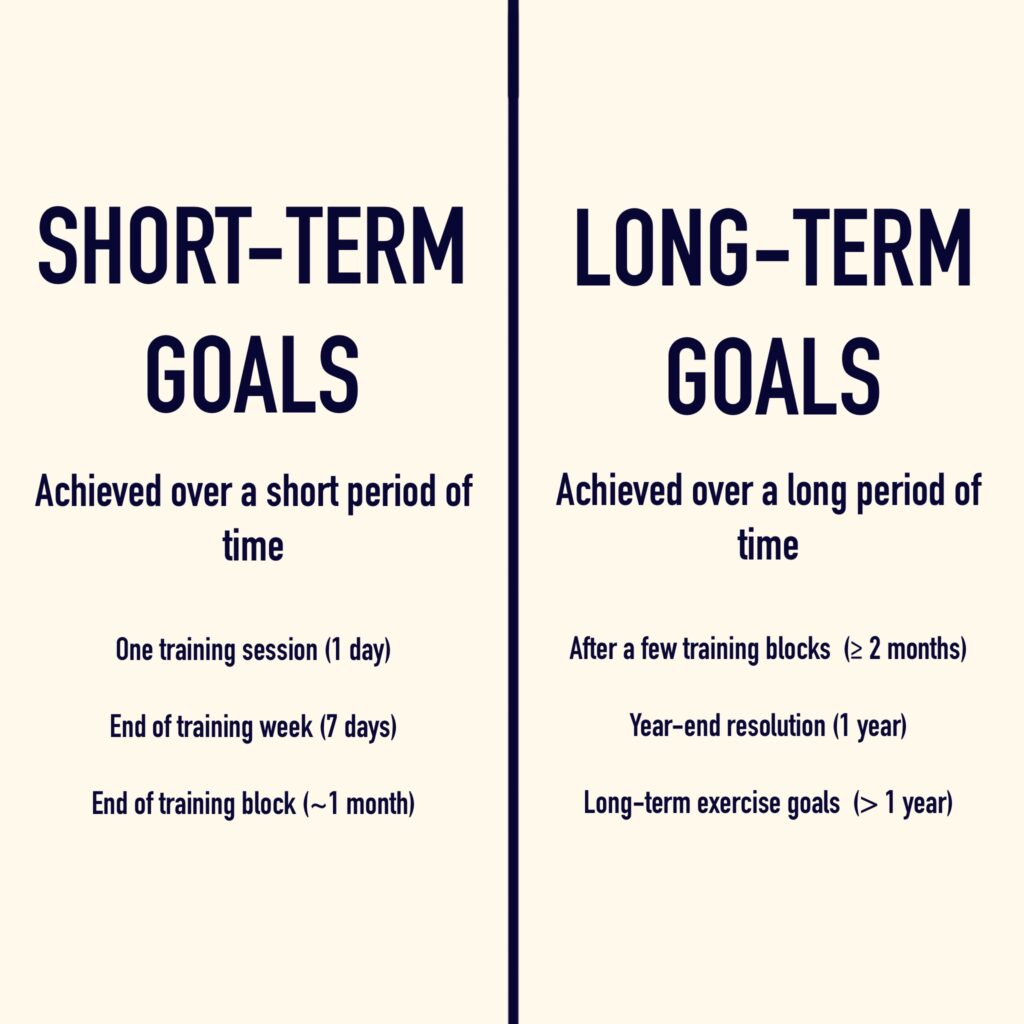
Both short-term and long-term goals have to be SMART — Specific, Measurable, Attainable, Realistic and Timed. Note that despite having recommended this principle, SMART goals are not easily identifiable right off the bat and in everyday context. This is not an exam and the SMART goal principle is just a guide. The idea is to learn how to generate these goals from your experience to meet your needs. Below are the short-term and long-term goals we can set for Lily as well as the steps to take to achieve these goals.
Review of Lily’s past training weeks and understanding Lily’s concerns about training for the next couple of weeks to generate a list of short-term goals
Lily’s training for the past couple of weeks has been irregular. There were days where Lily would train 3 days back-to-back or even split a training session into two when sessions take too long to complete. She also mentioned her busy school weeks as a University student and it is currently her crunch time. She also constantly feels tired and sore for most training the weeks before. Lily doesn’t know if it is okay to ask to reduce training days in a week and hence doesn’t suggest that to her coach.
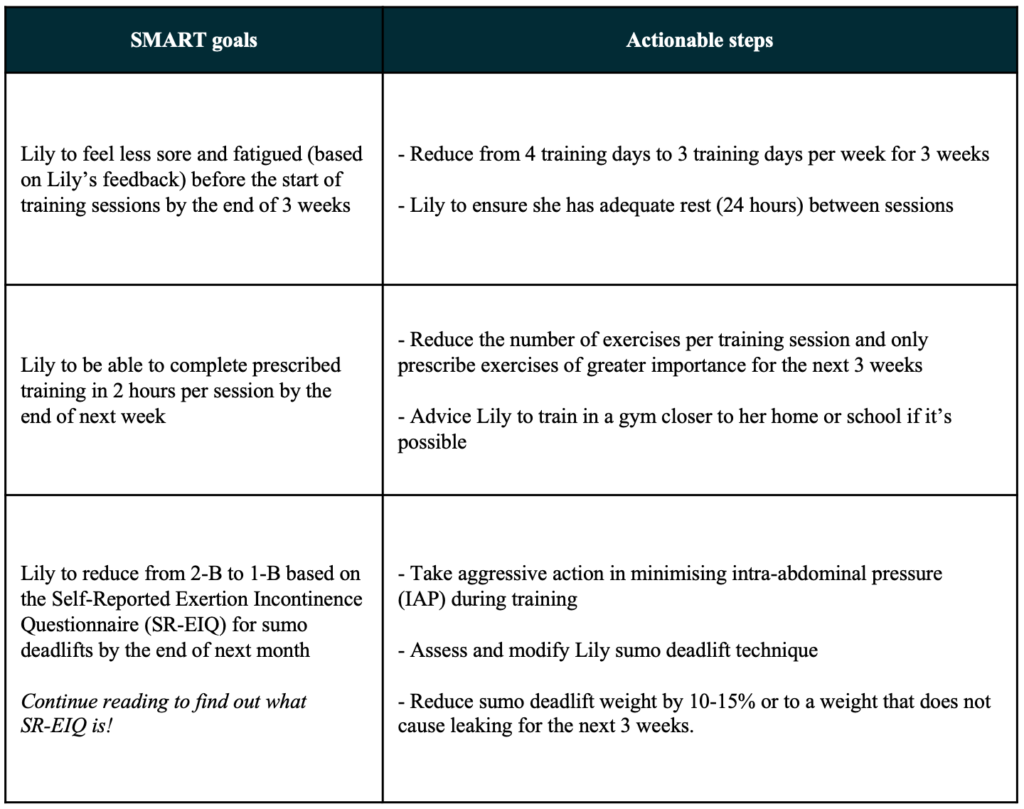
You can see that a period of 3 weeks is used throughout. Time is an important factor in rehabilitation. After 3 weeks, Lily’s readiness to return to pre-training routines should be assessed. If things are going well for Lily mentally and physically, sticking with the modifications made could be a viable option as well. Lily could have a better quality of life instead of being trapped in a continuous cycle of incontinence, tiredness and frustration.
Review of Lily’s SBD competition goals and understanding Lily’s concerns about training for the next couple of months/years to generate a list of long-term goals
Lily is still persistent with her current SBD goals for her upcoming competition in 4 months time even though it stresses her. It was really something she looked forward to after holding herself accountable for all the training she has done. At the same time, she is also worried it may permanently hurt her pelvic floor. She wants to fully eradicate leaking during deadlifting by competition day so she can focus on hitting her numbers.

Think of the goal-setting process as a session to manage each other’s expectations. This is the time for athletes to voice their concerns about training and it requires input from both athletes and their coaches. Coaches should also employ motivational interviewing for their athletes, especially when we have an athlete like Lily, who needs to align her expectations with her current training status to avoid overly ambitious goals and expectations.
Have you discussed your goals with your coach? How often do you discuss your goals with your coach? If you are not training with a coach, how often do you review your goals?
Feedback on Leaking
How do we measure this leaking experience during training to measure progress? Like how you’d have weekly/post-training feedback with your coach talking about the difficulties of your lifts i.e. RPEs, we can have something for leaking too!
Below is a questionnaire and its implementation that I’ve come up with to measure leaking while lifting. Let’s call it the Self-Reported Exertion Incontinence Questionnaire (SR-EIQ). It can be used for any type of lift that causes you to leak.
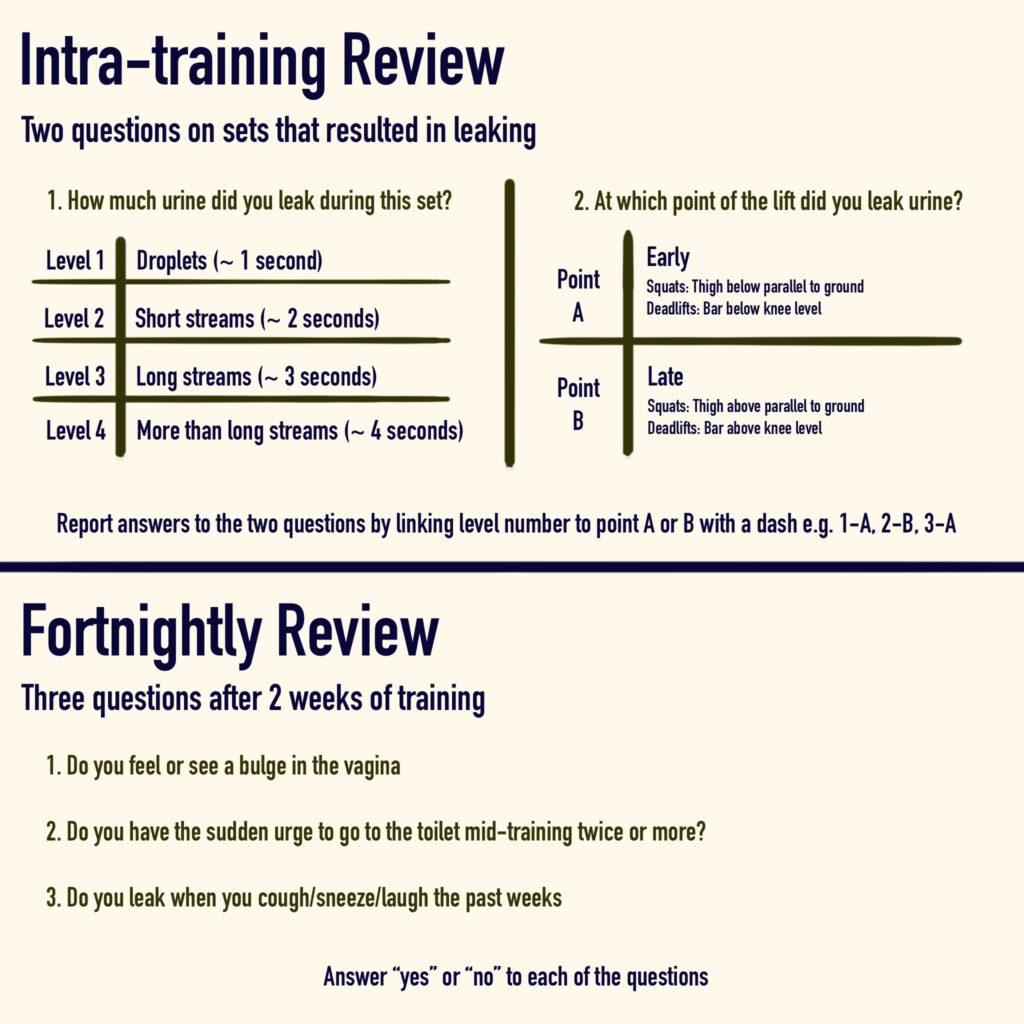

This questionnaire helps to screen for pelvic floor conditions that may arise from long-term resistance training. Such conditions include Pelvic Organ Prolapse, Stress Urinary Incontinence, Urge Urinary Incontinence, and Overactive Active Bladder. The items in the questionnaire were adapted from known validated questionnaires including the Incontinence Severity Index (ISI) (Sandvik et al., 1993) and Pelvic Floor Disorder Inventory (PFDI) (Barber, Neubauer, and Klein-Olarte, 2006). They were also rephrased to ensure clarity and ease of use during intra-training.
I hope this questionnaire provides a guide on how one should approach the situation when leaking occurs. At the same time, we need to understand that ratings like that have a subjective element to it. It is important for both the coach and athlete to have a mutual understanding of this scale (or any scale really) before utilising it.
training program modifications
In this segment, I will be presenting some modifications that we can make to our programme variables by going through Lily’s case.
I will also be evaluating why we experience more leaking during sumo deadlifts, so keep your eyes peeled!

What can Lily modify in her training programme and technique?
Follow the S-T-A-C-I principle when looking at training programme and technique modifications for leaking issues:
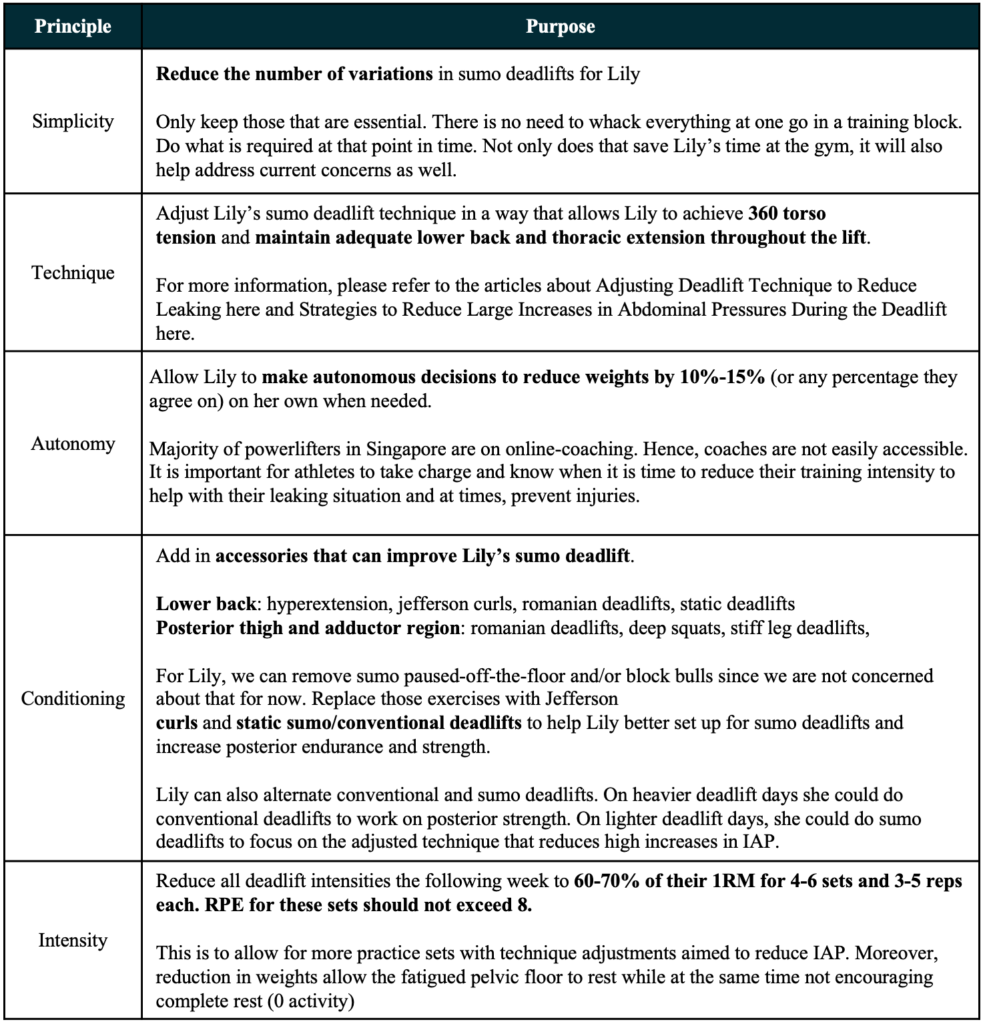
What do you think the coach has done wrong with Lily’s training week initially? Perhaps it has something to do with the communication between Lily and her coach? Or could Lily have some sort of responsibility in this scenario?
Soooo… Sumo and/or Conventional for Main Lift?
There have been questions around whether women should just switch to conventional because of their pelvic floor concerns.
The short answer is no, whilst the long answer is…
There is no safe or unsafe exercise. It depends on how one is adapted to the exercise. Some are born with pelvic floors that can withstand high increases in intra-abdominal pressure while some aren’t. There is an individual threshold to which one can withstand increases in intra-abdominal pressure (Bø and Nygaard, 2020). For those with lower thresholds, you can still sumo deadlift but will need more work in other areas to optimise your sumo deadlift technique. The coach’s job is to assess your lifts, monitor your leaking trends and help you achieve your lifting goals–which could possibly involve encouraging you to give conventional deadlifts a try or continuing to optimise on your sumo deadlift technique.
Still don’t know whether to pick Sumo or Conventional? Just need recommendations?
Let’s look at why Sumo pullers tend to experience more leaking than conventional pullers.
Leaking occurs when pressure inside the pelvic cavity (intra-abdominal pressure) exceeds the muscular control of the pelvic floor.
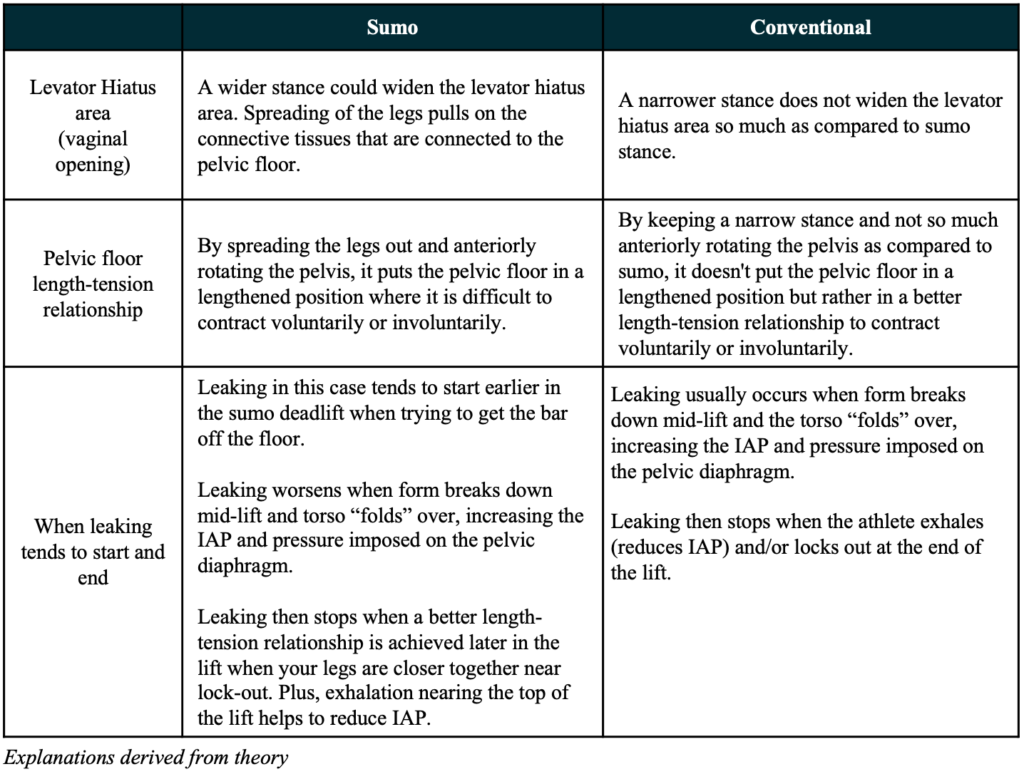
My advice is to switch to conventional as a main lift for now, build that posterior chain strength and pelvic floor tolerance to high intensities before progressively increasing the intensity for Sumo deadlifts.
I also recommend a criteria-based approach where progression for Sumo deadlift intensity depends on whether the athletes have satisfied a set of criteria.
Criteria before increasing intensities for Sumo deadlifts:
Not experienced leaking during training for the past 3 months
Has displayed consistent sumo technique execution during deadlifts for the past 3 months
Lily feels ready to return to sumo deadlifts at higher intensities (mental readiness)
Belt up or not?

There is no clear answer and it boils down to the case at hand.
If you are a beginner like Lily, perhaps a better option to build up technique and base strength is to work without the belt so that the use of the belt is viewed as a supplemental item, not as an essential tool.
If you are an intermediate or an advanced lifter, perhaps it is a better option to stick with using a belt and work on other areas outlined in this whole Leaking while Lifting series (I-IV).
optimising recovery
Lily has difficulty managing her recovery post training sessions
Recovery post training session consists of adequate sleep (Vitale et al., 2019) and nutrition (Heaton et al., 2017; Papadopoulou, 2020). Without turning this article into a book or cross-over to something not of my expertise, let’s only touch on the very first step to achieving adequate sleep and nutrition – effective Time Management. We need to allocate time to buy, cook and eat these foods. We also need time to track our macronutrients for those who are keeping a record. Not to mention the intermittent fasters who have to keep track of their time for consumption of food on top of everything else.
We are in this rat race where time is a valuable asset and time management is key for rest and essentially mental health.
Ways to improve Time Management:
To do-lists
Plan ahead and around training sessions
Setting realistic tasks in your schedule taking into account travelling time and rest time in between mentally draining tasks e.g. school and work.
Learning the art of habit stacking to pick up new habits on top of existing habits.
With Lily’s case example, Lily’s stress and outlook on lifting may be affected by external factors such as work, studies and personal expectations. Assess possible external factors that could cause Lily’s stress and aid Lily in her lifting journey by accommodating to her lifestyle.
Lily also has an ongoing dull pain in her lower back
If you are experiencing an injury now, it is important to address that injury first before moving on to tuning up on that intensity and adjusting technique to address the leaking issues. Just like how if you have a debt, you always solve the debt issue first.
As for Lily’s dull lower back pain, the same principles apply. First, we reduce the intensity to work on technique. Then, we add in accessory work to improve on their technique. Keep training simple with clear goals on what each exercise is supposed to improve on. Close communication about their injury and progress should be upheld between the athlete and the coach.
Sorry for not elaborating much about the many injuries we often hear about here… probably a discussion for another time.
wrapping it up!
Wow, that was a long ride. Thanks for sticking through.
In conclusion, making amendments to someone’s training programme is not as simple as changing their technique or deciding whether to go beltless. From Lily’s case example, we see that there are many factors to take into consideration. We have to look at the athlete’s goals and expectations, training programme, leaking progress and also a slight peek into Lily’s social and environmental stresses which can possibly impact her training performance.
disclaimers
All figures and criteria mentioned in this article are author suggestions and should be followed with caution. This article is directed at beginner lifters and coaches who are looking for direction when faced with leaking while lifting. We urge experienced lifters and coaches to come forward to share about their journey as an athlete or with an athlete and their leaking experiences.
acknowledgements
We would like to thank Jonus Ong (@jonus.ong) and Alex Poon (@thewritingphysio) for their input in this article, with training program recommendations and edits respectively.

